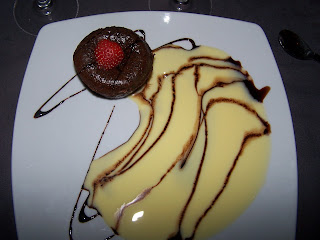
Le fontaine St. Michel
Wednesday I had to meet Dr. Clark and the other K-Staters at the Fontaine de St. Michel at 1 for our first official K-State cultural/history class. We walked from the Place St. Michel to the Musée du Moyen-Age/ Musée de Cluny. It was really interesting and slightly overwhelming- there’s just so much to see there. The 2 things that stuck out the most for me were les tapisseries de la dame à la licorne and the original têtes des rois from Notre-Dame de Paris. The Lady and the Unicorn tapestries are amazing in their detail and what they represent. There are 6 tapestries in total; 5 represent the five senses individually and the 6th represents ultimately renouncing worldly pleasures for a higher, spiritual purpose. At the time the tapestries were made to show the ideal lady, what she should look like and the fact that she should ultimately serve a higher power and not succumb to worldly temptations (i.e. the 5 senses represented in the tapestries). They are truly amazing in their workmanship and meaning.
Les têtes des rois require a slight history lesson to explain. If you look at the façade of Notre-Dame de Paris, there are 28 statues that represent the Kings of Judah and Israel in what is called the Gallery of Kings. In the 13th century when these statues were first added to the cathedral, they quickly became associated with the kings of France and were soon seen as representations of these kings and the French monarchy. Because of this association with the monarchy, the original statues were all torn down and beheaded during the French Revolution and Reign of Terror. During this time the people detested anything even remotely related to the monarchy and destroyed any and all artifacts with royal connotations. After the masses beheaded the statues, they simply threw the pieces into a cellar and buried them. Restoration of Notre-Dame began in 1843, and at the time, none of the original status remained on the façade. The architects put in charge of the restoration simply recreated the statues of the Gallery of Kings, and these 1843 kings are the ones that are seen on Notre-Dame today. In 1977, during some excavation/restoration work in another part of Paris, the cellar where the original heads had been thrown was discovered. Les têtes des rois seen in the Cluny today are those original heads from before the Revolution. The fact that so many of France’s historical sites were destroyed during the Revolution and today are actually reproductions/restorations makes seeing the original heads that much more amazing. All the sites here are amazing, but seeing the legit Middle Ages originals is even better. Another interesting aspect to these heads is the vestiges of paint of some of them. During the Middle Ages, all churches and religious monuments were painted, they were bright and colorful and full of life because religion was such an integral part of life. Looking at all the various monuments and churches today, we just assume they have always been basic stone, but in reality they were colorful, lively edifices. Seeing where there used to be paint, truly realizing the life and importance that was put into these objects, is simply mind boggling.
The point to that long winded history lesson: that’s one of the few stories/bits of information I honestly remember learning my freshman year of high school in my French 1 class. Because it did stick with me, actually seeing those original statue heads was really cool and very interesting for me. The entire Cluny is truly amazing in its displays and vast array of artifacts from the Middle Ages; it’s a definite must see if you’ve got the time while in Paris.
Les tetes des rois

You can kind of see some of the paint on this head...on the cheek where it looks slightly dirty, it's actually the remnants of paint.

After le Musée du Moyen-Age we walked over to the Collège des Bernardins for a bit. The collège was originally built by a chapter of les cistercien, an order of Catholic reform monks, as a center of learning to spread their religious teachings. Today the collège has been converted into a conference center, and it’s free for the public to tour.

The main gallery of le college with a modern art exhibit.
We then made a trek through the rain to l’Institut du Monde Arabe. The institute has an amazing library with anything you could need concerning the Arab world. There’s a terrace on the roof with quite possibly the best view in the whole city of Notre-Dame, so we went up to the roof for some quick pictures. There’s also a great little café on the first floor, which we then visited. Some of the best mint tea ever and absolutely amazing traditional pastries, such as baklava.


Le vue est superbe!
After my incredibly long day with Dr. Clark, I went home for dinner. After dinner Alice showed Nina and me around le Parc des Buttes Chaumont which is literally right across the street from our apartment. C’est très beau!

Les fleurs dans le parc.

You can see Sacre Cour from the cliff in the park...there are some amazing city views from here.


Nina and Alice



